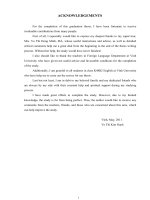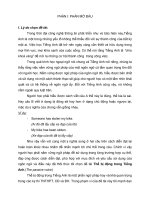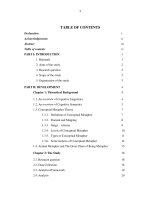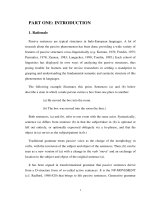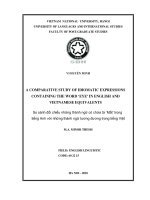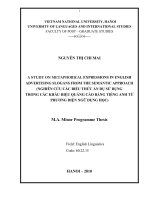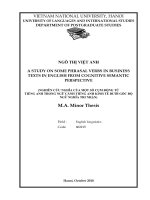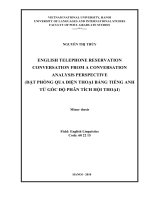the passive in english a perspective from cognitive semantics (with reference to vietnamese) = dạng bị động trong tiếng anh dưới góc độ ngữ nghĩa học tri nhận (có liên hệ tiếng việt
Bạn đang xem bản rút gọn của tài liệu. Xem và tải ngay bản đầy đủ của tài liệu tại đây (1 MB, 180 trang )
1
PART ONE: INTRODUCTION
1. Rationale
Passive sentences are typical structures in Indo-European languages. A lot of
research about the passive phenomenon has been done, providing a wide variety of
features of passive structures cross-linguistically (e.g. Keenan, 1976; Freidin, 1975;
Permutter, 1978; Zaenen, 1983; Langacker, 1990; Tomlin, 1995.) Each school of
linguistics has displayed its own ways of analyzing the passive structures, thus
posing trouble for learners and for novice researchers in settling a standpoint in
grasping and understanding the fundamental semantic and syntactic structure of this
phenomenon in languages.
The following example illustrates this point. Sentences (a) and (b) below
describe a state in which a male person carries a box from one place to another:
(a) He moved the box into the room.
(b) The box was moved into the room (by him.)
Both sentences, (a) and (b), refer to one event with the same actor. Syntactically,
sentence (a) differs from sentence (b) in that the subject/doer in (b) is optional or
left out entirely, or optionally expressed obliquely via a by-phrase, and that the
object in (a) serves as the subject/patient in (b.)
Traditional grammar treats passive voice as the change of the morphology in
verbs, with the inversion of the subject and object of the sentences. Then, (b) can be
seen as a new version of (a) with a change in the verb „move‟ and an exchange of
location in the subject and object of the original sentence (a).
It has been argued in transformational grammar that passive sentences derive
from a D-structure form of so-called active sentences. It is the NP-MOVEMENT
(c.f. Radford, 1988:420) that brings to life passive sentences. Generative grammar
2
offers an analysis of the change from active to passive structures, attributing the
shift through a „multilevel syntagmatic structure‟ in which the „deep structure (or
initial stratum) is basically active in organization‟ (Langacker, 1990.)
Passive structures are also argued to belong to a class of expression known as
idioms chunks (c.f. Radford, 1988:422.) And NPs in passive sentences do not have
the same syntactic freedom of distribution as other NPs. Another argument is
formulated in relation to thematic relations. It is claimed that active Objects (i.e.
Objects of active sentences) play the same thematic role as the corresponding
passive Subjects.
Another view on passive voice comes from Functionalism. Functional grammar
divides passive structure into three subcategories, depending on the functions that
the speakers would like to convey. It is called the pragmatic function of the
sentence. For example, when the Agent of the action is unknown to the writers or
speakers, passive structures are preferred. Or when the focus of the sentence is the
action and the effects of the action, not the doer of the action, passive constructions
are applied (c.f. Halliday, 1994; Lock, 1996; Downing and Locke, 1992; Givon,
1995.) Semantically, a functional grammarian analyzes constituents in passive
grammar based on the functions of the participants in the sentence, namely actor /
agent, goal, beneficiary, recipient, etc.
Previously mentioned views of linguistics on passive voice have left drawbacks
to language users and language teachers. For instance, traditional grammar states
that passive voice can be formed if the verb is a transitive one, i.e. the verb having a
direct object. However, not all transitive verbs can be conjured up in passive
structures. Or as stated by generative grammar, passive structures derive from their
active counterparts. In reality, no speaker describes an event by forming an active
sentence in his/her mind then „transforms‟ it into passives. This will be further
discussed later in the study.
3
It is not until recently that cognitive semantics (or more generally cognitive
linguistics) has postulated a different look at language structures. The focus in the
study of language shifts from external to internal, mentalist aspects of the human
language. Researchers in cognitive science argue that the linguistic structure is a
direct reflex of cognition in the sense that a particular linguistic expression is
associated with particular ways of conceptualizing a given situation (Lee, 2001: 1).
They believe that there exists an interrelationship between thought and meaning. It
is from this point of view that passive sentences are seen from a different angle.
The root of the differences mentioned above originates from the theory of
meaning. Generative grammar claims that the structure of linguistic expressions is
determined by a formal rule system that is largely independent of meaning. Or
rather, syntax is independent from meaning while cognitive linguistics claims that
language is not an autonomous cognitive faculty (c.f. Croft, 2004.)
It is therefore absolutely necessary for researchers as well as language learners to
take a standpoint in analyzing languages. In particular, a thorough understanding
and fully developed arguments for the explanation of the structure are crucial.
A note should be taken here regarding the title of the dissertation. Since the word
„perspective‟ in cognitive semantics embraces more than one meaning and has sub-
notions hanging with it, this word used in the title may result in misunderstanding.
However, the word „perspective‟ in the title is used in purpose. The meaning of the
word „perspective‟ the author wishes to express is that of „view point,‟ „standpoint,‟
„angle,‟ or the like. With the title as it is, the author wishes to analyze the passive
structures from the cognitive semantics point of view. More than that, the author
wishes to bring a metaphor of the word „perspective‟ to the title, hoping to create a
profound and thoughtful meaning of the title of the dissertation.
4
2. Aims of the study
The study aims to provide a critical analysis of three major theoretical
approaches of explaining language phenomena. More particularly, different
approaches of linguistics, e.g. traditional grammar, transformational-generative
grammar, on explaining passive voice will be critically explored, thus indicating
their strengths and weaknesses, which will help determine more appropriate ways of
looking at this language phenomenon.
The study aims at presenting another way of analyzing language structures,
especially passive structures, based on cognitive linguistics, particularly cognitive
semantics, i.e. based on four major notions: Perspectives, Figure – Ground
relationship, Encyclopedic knowledge, and Prototype. An exploration of cognitive
linguistics in general and cognitive semantics in particular will be displayed, thus
providing a more interesting and convincing way of looking at the passive voice.
Major tenets of cognitive linguistics and features of cognitive semantics will be
thoroughly presented, making it possible to come to a conclusion for the betterment
of the new school of linguistics.
The study will also discuss the possibility of the existence of passive structures in
Vietnamese. A prototype view will be applied in analyzing the structures, hopefully
contributing another view to the debate over the existence of the so-called passive
structures in Vietnamese.
Through the analysis of passive structures, the researcher attempts to present
another view of linguistic exploration, interpreting the use of language from the
understanding of our cognition through a number of notions in cognitive linguistics,
and in cognitive semantics in particular, thus illustrating evidence for the possibility
of integrating notions in cognitive semantics in the task of language analysis.
5
3. Scope of the study
As stated previously, one of the aims of this research is to present our
understandings of cognitive linguistics and cognitive semantics in particular;
therefore, the focus is on displaying major notions of this school of linguistics. In
particular, the study confines itself to the notions of perspectives, figure and ground,
encyclopedic knowledge, and prototype since these four are fundamental in
cognitive linguistics.
Regarding passive voice and structures to be analyzed, the study restricts itself to
structures with passive form in the main verb, i.e. the passive form of the utterance
is in the head verb, leaving behind structures consisting of passive forms in other
parts of the sentence, e.g. in the to infinitive, such as need to be repaired. Also, most
sentences used as illustrations come from everyday language, thus setting aside
extensive complicated sentences found in academic texts or elsewhere.
It should be noted here that it is not possible to apply one notion of cognitive
linguistics, such as Figure and Ground, in analyzing all kinds of passive structures.
This means that for each sentence, we have different ways of approaching and
applying proper notions for explaining. This is due to the fact that language
phenomena are various, and as a result, the way to deal with them varies
accordingly. Consequently, it is impossible to apply one idea to the explanation of
all features of language. However, the study is not going to categorize or classify
which kinds of sentences are applicable for which types of notions since it is not the
goal of the study. The last chapter in Part II is an attempt of assembling as many
notions as possible in analyzing the phenomenon of passive structures, thus
providing a broader view on this feature of language - passive structures. In short,
the study will focus on the facets that are applicable in analyzing passive structures,
not an overall presentation of the theory of cognitive semantics.
6
4. Research questions
Passive voice in English, or in Indo-European languages in general, has been
widely discussed from different points of view. Different papers present different
discussions on this language structure. This study attempts to seek answers to the
issues that have not been adequately discussed by many researchers from different
schools of linguistics. The questions that the study will investigate will be as
follows:
a. How is the passive voice seen from the point of view of cognitive semantics?
Different major notions of cognitive semantics are applied to discuss the
phenomenon, i.e. passive voice, resulting in 4 subquestions as follows:
Subquestion 1: Are passive sentences surface structures of their so-called
active counterparts? How are passive and active sentences seen from the
notion of „perspective‟ in cognitive semantics?
Subquestion 2: How can the notion of Figure and Ground be applied to
explain passive structures?
Subquestion 3: How can the theory of Frame Semantics and
Encyclopedic Semantics be used to examine the acceptability of passive
sentences?
Subquestion 4: How can the theory of prototype be used to formulate a
passive prototype in Vietnamese?
b. Is it possible to integrate the four notions in analyzing passive voice,
providing a thorough and profound interpretation of the phenomenon?
7
5. Methodology
5.1. This work is not an empirical study which requires experimental and/or
experiential data, which is analyzed using quantitative or qualitative methods. In
contrast, the study applies the descriptive and analytical methods, presenting the
theoretical foundation which is then illustrated by examples with explanations and
discussions, thus hopefully reaching conclusions by deductive reasoning.
A theoretical framework, i.e. based on the major notions of cognitive semantics,
is established; then examples and illustrations are explored based on this
framework. In other words, major notions of the cognitive semantics theory are
used as principles from which examples are analyzed, thus helping the researcher
come to conclusions.
The examples and illustrations given in the discussion are utterances from
different specific situations in daily life. Sentences used as examples are cited from
either reliable sources or real life situations. All the examples from real life
situations, though not recorded and not put in the appendices, were sent to English
speaking people to test whether these sentences have a high acceptability in the
English language. More significantly, two native English speakers have been asked
to do the proof reading, providing high reliability and validity of the examples used
in the work.
5.2. The research design is presented as follows. First, in order to establish a
strong argument for the work to be done, all major points of views and the methods
of analyzing passive structures are critically illustrated. Then a framework is set up
from the light of cognitive semantics, i.e. a framework set up from four major
notions of cognitive semantics. Each of these four notions is presented with details
and illustrations, with which active and passive structures are analyzed and
explained. After that, an integration of these four notions is founded, from which
passive structures are analyzed from the overall examination of cognitive semantics.
8
This dissertation is divided into three parts. The first one is, as a rule of thumb,
the Introduction, which provides the rationale, aims, scope and research questions
of the study. This rationale provides arguments for the necessity of carrying out the
research; the aims presents the goals of the study and the scope restricts the study
into a certain aspects and leaves behind others for other future research.
The second part of the dissertation, the Development, presents a thorough review
of the literature about passive voice, in English and Vietnamese. More importantly,
a theoretical framework based on major notions of cognitive semantics is
established, providing foundation for the discussion and analysis of the passive
voice from the light of the cognitive semantics.
In part II, there are five chapters. Chapter 1 reviews major arguments and
analysis of passive voice from different schools of linguistics other than cognitive
linguistics. Chapter 2 presents the basic ideas about cognitive linguistics and
especially cognitive semantics. Chapter 3, 4, and 5 are for applying individual
notion of cognitive semantics to analyzing and discussing passive and active
structures. Regarding the necessity and vitality of the analysis of passive voice,
Chapter 1 presents different views of different schools of linguistics, and the
drawback of these methods in analyzing language. Chapter 2 displays how language
structures are seen from the perspective of cognitive semantics, providing a
foundation for a particular phenomenon, i.e. passive structures, to be analyzed.
Chapters 3, 4, and 5 discuss the passive phenomenon based on the notions of
cognitive semantics presented in the previous chapters.
The last part of the work, the Conclusion, summarizes what has been done, what
has not been covered, accompanied by suggestions for future study. This part also
indicates possible implications for the job of language teaching and learning,
hopefully providing an alternative method of analyzing other aspects of languages.
9
6. Contribution of the study
The study hopes to contribute to the development of cognitive linguistics, and
cognitive semantics in particular, thus providing evidence for the claim that
cognitive linguistics is a convincing and appropriate way to explain language.
The study confirms the fact that it is feasible to apply notions in cognitive
semantics to analyzing and explaining problems in syntax, thus fostering the idea
that syntax and semantics are two sides of a coin, and should not be considered
divorced from one another.
The study provides a profound and convincing explanation, with illustrations and
examples in English and Vietnamese, to the controversy of whether passive voice
derives from active voice, which hopefully contributes to the aim of settling the
arguments referring to the phenomenon of passive voice.
10
PART TWO: DEVELOPMENT
In this Part, a review of theoretical foundation is done in the first half, serving as
a background for the study to be carried out in the rest of the part. This part consists
of five chapters. The first chapter deals with the arguments about passive voice
from three major linguistic theories, i.e. traditional grammar, transformational-
generative grammar, and functional grammar.
The first half of Chapter 2 displays the author‟s understanding of cognitive
linguistics in general and cognitive semantics in particular. This chapter confines
itself to the major points which will be applied to the analysis of passive voice in
the following chapters. The chapter starts with a definition of technical terms which
will be applied in the discussion; and it is followed by a general view on cognitive
linguistics. Then the chapter continues with an illustration of my understanding of
cognitive semantics, which serves as foundation for the study.
The rest of Chapter 2 presents an intensive review of major tenets of cognitive
semantics which have been applied in analyzing linguistics expressions. The chapter
displays four major notions of cognitive semantics, providing a theoretical
framework in the discussion of the phenomenon of passive voice in the following
chapters. The notions include Perspectives, Figure and Ground relation, Frame
Semantics and Encyclopedic Semantics, and Prototype.
Chapters 3, 4, and 5 are the core of the study. Chapter 3 applies the four major
notions of cognitive semantics, which have been displayed so far, into analyzing
passive structures. The discussion of passive structures are based on the major
tenets of cognitive semantics.
Chapter 4 deals with the passive structures in Vietnamese. Two major arguments
about whether or not there exist passive structures in Vietnamese are presented.
Then the chapter continues with the implementation of prototype theory in
11
proposing a passive prototype in Vietnamese after a deep discussion of the
existence of the passive structures in Vietnamese.
Chapter 5 is an attempt of integrating all notions in analyzing passive structures
and related issues, thus providing a thorough interpretation of the phenomenon of
passive voice from the perspective of cognitive semantics.
12
Chapter I - Passive Voice
1.1. Introduction
This chapter presents the analysis of the passive voice from major schools of
linguistics, namely traditional grammar, transformational-generative grammar, and
functional grammar. Discussion on the analysis will also be provided, presenting
what is needed to be explored, or the flaws that triggered me to apply another way
of explaining this language phenomenon.
Most of the examples used in this chapter are constructed especially to exemplify
the meanings and patterns under discussion with the principle that when one begins
to deal with real language use, things should be really so simple or so short (Baker,
1999.) Sentences used to illustrate the arguments primarily come from everyday
conversations and uttered spontaneously, and sentences cited from reliable sources.
1.2. Traditional grammar and passive voice
Traditional grammar considers passive voice as the change in form of the
transitive verbs. Traditional grammarians attribute the change of voice to the change
in form (morphology) of the verb. They claim that any transitive verb in active
voice has its counterpart in passive voice. In the example below, sentence 1.a. is in
active and 1.b is in passive:
1. a. Alice found the ball.
b. The ball was found by Alice.
c. The ball was found.
Sentences in 1 refer to the same event, and according to traditional grammar,
they have the same meaning(s). The reasons of the passive usage (e.g. in 1.b or 1.c)
is attributed to very superficial reasons, e.g. because it is not necessary to mention
13
the doer, not knowing the doer, the doer being „people,‟ etc. (c.f. Thomson &
Martinet, 1960; Sinclair, 1990.)
The difference between the active sentence 1.a and the passive sentence 1.b or
1.c is superficially explained as a change in the morphology of the verb which must
be transitive; and the object of the sentence in active voice becomes the subject of
the passive counterpart.
The fact is that in many cases meaningful active sentences with transitive verbs
become abnormal if they are transformed into passive voice. For example, we can
say that „The shoes do not fit me‟, but rarely or never do we hear a sentence like „I
am not fitted by the shoes.‟ Moreover, it is undeniable that when one wishes to use
a different linguistic expression, she/he does want to convey a different meaning in
her/his utterance. Consider the following pair of sentences and see how the active
differs from the passive.
2. a. That man kicked the girl.
b. The girl was kicked by that man.
The sentences do not only differ syntactically but also semantically. While 2.a
may express the writer‟s intention to draw readers‟ or listeners‟ attention on how
brutal that man is, or rather on the vicious nature of the man, neither on the girl nor
on her injuries. On the other hand, with the sentence 2.b in passive form, the writer
obviously targets at his audience to sympathize with the girl and the way she has
been treated by the man. This example is a convincing illustration of the fact that
we would not have a profound understanding of the passive voice if we analyze and
interpret the meanings of passive and active sentences from the perspective of
traditional grammar. As a result, we need a different approach to deal with this
phenomenon of language.
14
1.3. Passive from the perspective of transformational - generative
grammar
1.3.1. In early transformational-generative grammar, the relation between active
and passive voice was accounted for by an optional transformation which is applied
to an underlying structure common to both actives and passives. The passive –
active relation was considered a derivational one which means that to a certain level
of representation, “actives and their corresponding passives were identical”
(Freidin, 1975.) According to Chomsky‟s Syntactic Structures model, a common
underlying structure could be mapped onto two distinct surface structures – one
passive and the other active. The chart below illustrates the relationship between
passive and active.
UNDERLYING STRUCTURE
T-Passive
SURFACE STRUCTURE
1
SURFACE STRUCTURE
2
(Extracted from Freidin, 1975)
SURFACE STRUCTURE 1 accounts for active sentences, which are not
discussed here in this study. The second type of structure which derives from the
underlying structure is SURFACE STRUCTURE 2 which is formed after a change
in the noun phrase called NP movement. The sentence below (3) is passive and it is
argued that the italicized NP [the car] originates from the post-verbal object
position marked -
as the following:
3. The car will be put
__
in the garage.
(Radford, 1988:420)
15
And the NP [the car] is subsequently moved out of there into the italicized
preverbal subject NP position. The process can be described schematically in 4
below:
4. [
S
[
NP
e] will be [
V
put [
NP
the car] in the garage.]
NP MOVEMENT
Transformational grammar claims that the subject the car in the passive sentence
3 originates at D-structure in the „post-verbal Object NP position‟ in 4. In other
words, the passive sentence 3 derives from a D-structure, the active sentence in 4
(c.f. Radford, ibid.)
1.3.2. One of the arguments for the analysis of passive structures proposed by
transformational grammar is attributed to a class of expressions called idiom
chunks. It claims that since there is a class of English Noun Phrases which are
highly restricted in their distribution, which means that these NPs, in their idiomatic
use, generally occur only in junction with some specific verbs. The italicized NPs in
5 below are called idiom chunks since they do not have syntactic freedom of
distribution as other NPs – for example, they cannot occur in typical NP positions
like in 6 below.
5. a. She just PAID little attention to his report.
b. Let‟s TAKE advantage of the warm weather.
c. The government KEEPS tabs on his operations.
6. a. ? She has attention to him.
b. ? I need the advantage.
c. ? Tabs won‟t affect me.
(c.f. Radford, 1988:420-446)
The italicized NPs in 5 generally occur after the capitalized verbs and do have
the freedom of distribution as illustrated in 6. Sentences in 6 do not normally
happen because they seem unnatural in conversation, and they are said to be ill
formed.
16
Transformational grammar claims that the restrictions are essentially lexical –
syntactic, which means it just happens to be an arbitrary syntactic fact about the
distribution of the terms like attention, advantage which are virtually never used in
contemporary English in any situation immediately following the verb have and
need receptively. It is then said that the object idiom chunk NPs such as attention,
or advantage, etc. “have extremely restricted distribution (i.e. are generally
restricted to occurring immediately after specific verbs,” (Radford, 1988: 423) like
pay or take.
For passive constructions, it argues that some idiom chunk NPs can only precede
certain verbs by undergoing a movement to the preverbal positions from their
original positions in active structures. Sentences in 7 below illustrate the point:
attention and advantage can only precede the verbs PAY and TAKE respectively by
moving from their original places marked
__
to the initial placed functioned subjects
in the sentence. This means that these NPs are restricted to occurring immediately
after specific verbs at D-Structure even though “they can move out of their
underlying position by movement rules like NP MOVEMENT” (Radford, 1988:
424.)
7. a. Little attention was PAID
__
to his report.
b. Little advantage was TAKEN
__
of the situation.
The NPs attention and advantage in 7.a and 7.b above are moved from their trace
marked
__
. Transformational grammar claims that these sentences originate from D-
structures which the NPs attention and advantage can only follow certain verbs, and
are called idiom chunk NPs.
1.3.3. Another argument posed by transformational grammar in describing the
passive voice is related to thematic relations which come from Chomsky‟s Theta
Theory. Theta Theory is a part of Government-Binding Theory which discusses the
assignment of theta roles for Arguments, i.e. NPs, in a sentence. In other words,
17
each Argument bears a particular thematic role (or theta-role or θ-role), e.g. Agent,
Patient, Experiencer, Instrument (c.f. Chomsky, 1981; Radford, 1988)
Regarding passive sentences, Theta theory states that the active objects, i.e.
objects of the active sentences, “play the same thematic role as the corresponding
passive subjects” (Radford, 1988: 424.) For instance, in the active sentence 8.a
below the italicized object NP plays the same semantic role (i.e. theme, or patient)
as its italicized subject NP in the corresponding passive 8.b:
8. a. They moved the chair out of the room.
b. The chair was moved out of the room.
Similarly, in sentence 9.a below the italicized object NP Alice has the same θ-
role (i.e. goal) as its italicized subject counterpart in the corresponding passive 9.b:
9. a. They will send Alice a new laptop to replace the old one.
b. Alice will be sent a new laptop to replace the old one.
In the above sentences, passive subjects in 8.b and 9.b play the same theta-role as
the corresponding active objects in 8.a and 9.a. This is because, according to
Transformational grammar, in passive sentences the subject which is considered as
superficial subject NP originates at D-structure as the objects of the passive
participle. In the sentence below, for example, Alice is the object of the passive
participle; in other words, the lexical entry send specifies that NP immediately
following send in [V NP NP] structures is assigned the theta-role of GOAL; then it
follows that the italicized NP Alice in the following sentence will be assigned the
role of GOAL at D-structure:
10. [
NP
e] will be [
V
sent Alice a new laptop.]
In sentence 10, the theta-role is „preserved‟ under movement, so that when NP
movement applies to „passivize‟ Alice (i.e. move Alice from object to subject NP
18
position), Alice retains the theta-role of GOAL. The operation of the rule that is
applied in 10 is illustrated as the following:
S
NP I VP
e will AUX V
be V NP NP
sent Alice a new laptop.
NP
MOVEMENT
1.3.4. One more view from transformational grammar initiated by Wasow (1977)
is that passive voice is seen in two different types: adjectival and verbal. The
adjectival passives show the adjectival nature of passive participles which are
pronominal and complement to certain verbs, e.g. act, look. Some examples of the
adjectival passive are as follows:
11. a. The
edpa
broken
int
box sat on the table.
b. John
looked
acted
annoyed
happy
at
us
(Wasow, 1977:339, cited in Murphy, 2004)
Wasow further poses some evidence for his argument that some passives are seen
as adjectives: A number of verbs can be prefixed with un- only when they are
passivized.
19
12. a The island was uninhabited by humans.
b. All his claims have been unsupported by data.
c. Her whereabouts may be unknown.
13. a. * Humans uninhabited the island.
b. * Data have unsupported his claims.
c. * They may unknown her whereabouts.
(Wasow, 1977:339, cited in Murphy, 2004)
Sentences in 12 are considered well formed but not in 13 which are marked by an
asterisk (*). Wasow states that these italicized words can only serve as adjectives
not as verbs, which leads him to the conclusion that passives can also be seen as
adjectives. Wasow argues that the rule that derives adjective passives must be a
lexical rule if it changes a verb into an adjective. The second type of passive,
according to Wasow, is called verbal passives which are derived by a
transformational rule. The rule Wasow mentions has just been analyzed previously.
Regarding the unrelatedness between transitivity and passivization, several
scholars state that it lies in the semantic properties of the transitive verb, i.e. the
affectedness of the Patient, the change the Patient undergoes by the force of the
Agent (c.f. Sudo, 2000.) In other words, when there is no change in the patient,
there is no possibility of passivizing an active sentence. Bolinger (1977) illustrates
the following examples:
14. a. John Smith deserted the army.
b. ? The army was deserted by John Smith.
15. a. All the generals deserted the army.
b. The army was deserted by all the generals.
According to Bolinger, the army, the Patient, is not affected if only Smith deserts
the army. However, if all the generals do, the army will definitely be affected, thus
20
causing a significant change in the structure of the army. Therefore, sentence 14.b
does not show a high acceptability, and it sounds unnatural to English speakers.
Bolinger‟s explanation seems to be logical to most of the cases on transitivity.
However, a number of different cases when there is not a high acceptability for the
passivization can not be attributed to the affectedness of the Patient. Take sentence
16 for example.
16. a. He has to park parallel the car for her.
b. ? The / Her car had to be parked parallel.
There is no question for the idea of affectedness to the car since at least when the
man parks parallel the car, he changes/affects the car in terms of space; but sentence
16.b still sounds unnatural. This constraint leads to the fact that we need a different
way of explaining the acceptability of a structure, i.e. passivization, not just the
affectedness of the Patient.
1.3.5. We have briefly presented the early approaches to syntax by generative
grammar, which are based largely on structural properties such as linearity and
dominance. However, transformational grammar was “criticized by Relational
Grammarians who emphasize the importance of taking grammatical relations into
consideration” (Shibatani, 1985.) Perlmutter and Postal (1977) pose some problems
with a universal characterization of passives if grammatical relations are not
mentioned. They propose a universal characterization which depends on
grammatical relations. They assume that “a clause consists of a network of
grammatical relations. Among these relations are „subject of,‟ „direct of,‟ and
„indirect of.‟ (Perlmutter and Postal, 1977; 399.)
Regarding passive constructions, Perlmutter and Postal present a summary as
follows:
21
- A direct object of an active clause is the (superficial) subject of the
„corresponding‟ passive.
- The subject of an active clause is neither the (superficial) subject nor the
(superficial) direct object of the „corresponding‟ passive.
- In the absence of another rule permitting some further nominal to be direct
object of the clause, a passive is a (superficially) intransitive clause.
(Perlmutter and Postal, 1977: 399)
Perlmutter and Postal argue that a universal characterization of passives can be
best obtained not in terms of word order, case, or morphology, but rather in terms of
a change in grammatical relations. Mentioning passive, they argue that it should be
characterized in terms of a relational network in which a nominal – the direct object
in a transitive stratum – bears the subject relation in the immediately following
stratum. In other words, according to Perlmutter and Postal, “passive is a
„promotional‟ phenomenon, whereby a direct object nominal at one level is a
subject nominal at a later level” (Shibatani, 1985.)
Although Perlmutter and Postal have provided evidence for their arguments, they
have been criticized for the fact that not all passives show a promotion of a direct
object despite the fact that subject demotion occurs, e.g. impersonal passives.
Shibatani (ibid.) shows that the approach by Relational Grammar is “too restricted
to account for the patterns of distribution which a passive morphology exhibits.”
1.3.6. Major arguments from the perspectives of distinguished linguists of the
school of generative grammar have been presented. Briefly, generative grammars
have shown three basic features. One of which is that the synonymy is handled
through a multilevel syntagmatic structure for passive clauses, in which the deep
structure (D-structure) is basically active in organization. The second feature is that
the objects of by in passive structures are considered as a „demoted deep-structure
clausal subject‟ (Langacker, 1990:127.) The third primary feature is that “all or
22
some of the grammatical morphemes marking the passive construction (by, be, and
the perfect participle inflection) are meaningless entities, with purely formal or
syntactic function” (Langacker, 1990: 127.)
In other words, the generative approaches to the passive focus primarily on the
lexical-semantic and structural characteristics of the construction. These arguments
have triggered many debates for the last few decades. The drawbacks of the
approaches of generative grammar will be discussed later on in this study.
1.4. Passive voice from the perspective of functional grammar
1.4.1. Functional Grammar (henceforth FG) is an approach that analyzes the
grammatical categories in terms of their communicative functions. Language is seen
as a system of communication, and grammar is analyzed with an attempt to discover
how it is organized to allow speakers and writers to make and exchange meanings
(c.f. Lock, 1996: 1.)
FG possesses a number of features. First of all, grammar is modeled as a set of
choices. Language is organized in categories so people can select the category that
they need to express what they want. For example, when communicating, language
users must choose whether they are going to make a statement, a question, or
something else. Making a question, or expressing a statement, etc. is said to be the
function of the language.
Second, FG argues that language use has shaped the language system (Halliday,
1994: xiii;) therefore, grammar should be looked in a way in which it is used to
construct texts in their „context of use‟ (Halliday: ibid.) Functional grammar is
concerned with how language is used in contexts, not in separate sentences, or
words that we can see in traditional grammar books.
Third, FG states that “the fundamental components of meaning in language are
functional components” (Halliday: ibid.) It is concerned with the way in which
23
grammar is organized to make meaning. FG claims that all languages are organized
around three primary functions or meanings. First, it is experiential meaning:
language is used to express one‟s feelings about the surrounding world „to
understand the environment‟ (Halliday: ibid.) Experiential meaning has to do with
the ways language represents our experience (actual and vicarious) of the world as
well the inner world of our thoughts and feelings. Experiential meaning is about ho
we talk about actions, happenings, feelings, beliefs, situations, states, etc., the
people and things involved in them, and the relevant circumstances of time, place,
manner, etc. (c.f. Lock, 1996: 8-9.)
The second type of function language serves is to interact with people, i.e.
interpersonal meaning. Interpersonal meaning is concerned with the ways in which
we act upon one another through language, e.g. giving and requesting information,
getting people to do things, etc., and the ways we express our judgments and
attitudes.
The third type of meanings in FG is textual meaning. One sentence may have
different meanings in different contexts. In other words, language is used to
organize messages so that they fit with other messages around them; textual
meanings indicates the ways in which language is organized in relation to its
context (c.f. Halliday, ibid., Lock, ibid., Downing, 1992.)
1.4.2. Regarding passive voice, Halliday (ibid.) states that in clauses containing
Agents, i.e. doers, the clause is in passive voice if the Medium, i.e. the key figure
through which the process is actualized, and without which there would be no
process at all, serves as subject and the Agent as the adjunct. He claims that there
are two major reasons for choosing passive voice: First, to get the Medium as
Subject, and therefore as unmarked Theme, and second to make the Agent either (i)
late news, by putting it last, or (ii) implicit, by leaving it out (page: 168 – 169.)
Lock states that “the selection of passive voice allows the speaker or writer to
thematize participants,” (1996: 233) such as Goals, Recipients, without producing
24
marked Themes. Take for example the following pair of sentences, in sentence 17.b,
the Goal (the statue of David) is thematized, but as it is to the Subject, the Theme is
unmarked:
17. a. Michelangelo finished the statute of David in 1504.
b. The statute of David was finished (by Michelangelo) in 1504.
Another reason for the selection of passive voice, according to Lock (ibid.), is
motivated by “the desire not to switch the Theme,” or “to maintain continuity”
(Downing, 1992: 255;) for example:
18. She put her head out of the window and was struck full in the face by
a snowball.
(Lock, ibid.)
In 18, the Theme of the second clause is still She although it is ellipsed. The
selection of passive voice in the second clause is to remain the Theme She without
producing what would be a very marked thematic structure.
According to Downing and Lock (1992: 251) there are three major possibilities
that speakers may use passive voice to express their point of view of the textual
organization; the first possibility to use passive may come from the fact that the
Agent is New information; as a result, the Agent is placed last. Take for example
sentences in 19 below:
19. a. Where did you get that silver bangle?
b. It was given to me by my BOY-friend.
GIVEN NEW
Also, an additional motivation for the use of a passive with an Agent by-phrase
occurs when the Agents is long; and the writer or speaker follows the principle of
25
end-weight („shortest first, longest last‟). An example of this kind can be seen in
sentence 20 below:
20. a. The front seats were filled by members of the families of the victims.
b. The goal was scored by Barry Lee, the player with most
goals to his credit this season.
Another possibility that may condition the choice of between active and passive
is when the Agent is not New and is silenced, leaving the other element which is
New and placed last. The reason for silencing the Agent, according to Lock, may
vary. Take for example the followings:
21. a. He was killed in the Second World War. {unknown}
b. I‟ve been finished compiling the catalogue and it has been sent to
the printers. {already been referred, directly or indirectly}
c. Prisoners are allowed visitors only once a month. {understood from
context}
d. That solution has never been proposed. {Agent is „people‟ or „one‟}
e. The documents have been thrown away. {to highlight Predicator}
f. I‟m afraid the Fax hasn‟t been sent. {to be polite or to avoid
blaming someone}
Lock (ibid.) further presents some possibilities that determine the voice section.
One of which is to focus on a verb, in other words, to leave the end-focus to the
verb which is stated last, e.g. This must be seen to be believed; Moreover, passive is
also used in cases the Adjunct, or Complement, or the Prepositional Object in the
sentence receives the important end-focus, e.g. He was taken to jail; The letter has
been sent unstamped; or The retiring chairman was presented with a golden watch.
